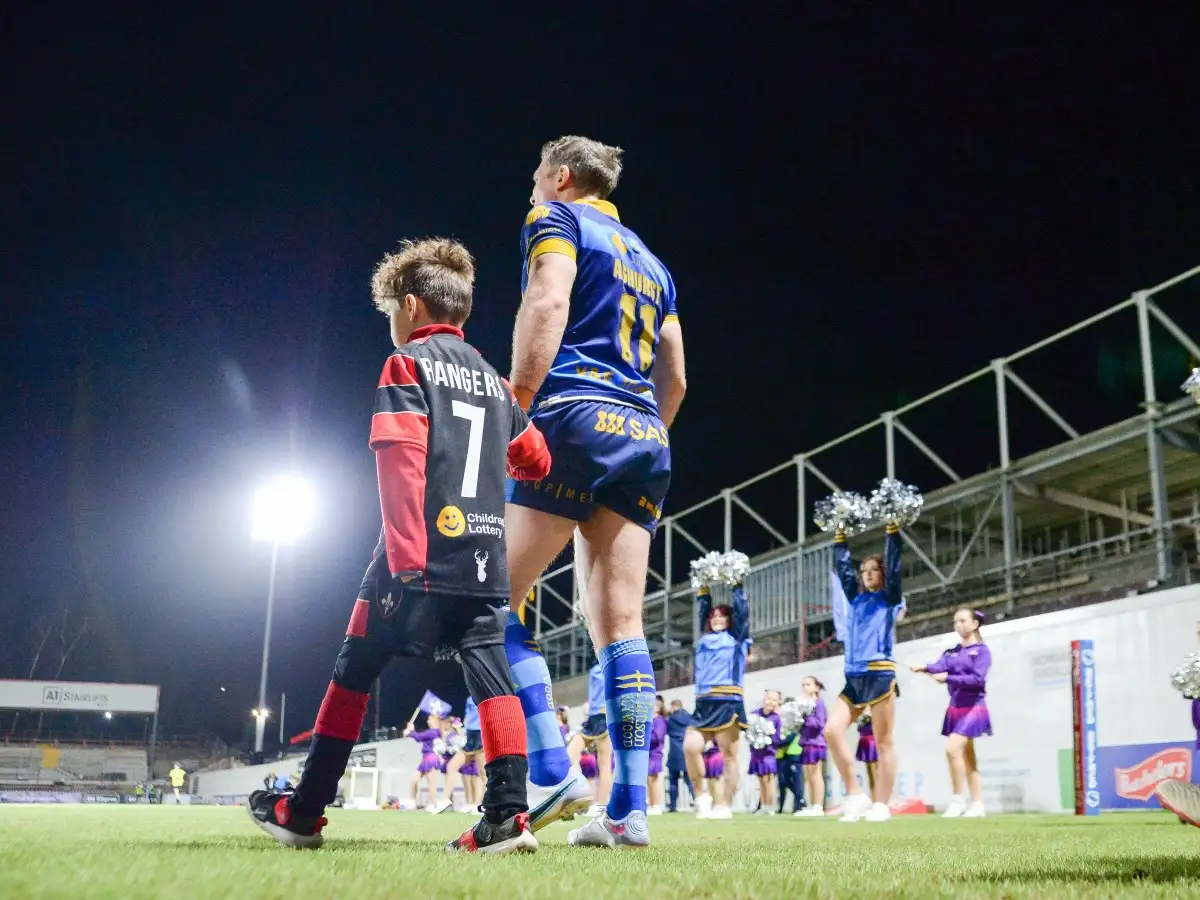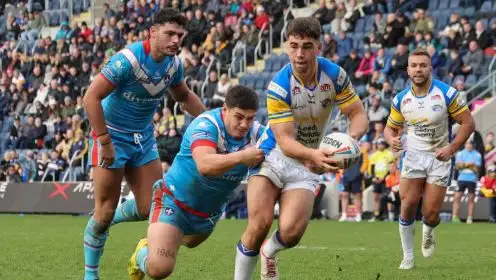Wakefield stadium work makes them solid Super League proposition

Credit: Craig Cresswell/Alamy Live News
They might have started the new Super League season as relegation favourites, but the off-field progress being made at Wakefield could secure their long-term future in the top flight.
Being written off in pre-season is nothing new to Trinity, who are yet to suffer the drop since being promoted to Super League in 1998.
Only once have they finished bottom of the table, in 2015 when they survived by beating Bradford in the Million Pound Game, and it hasn’t always been about survival either – they finished 5th in consecutive seasons in 2017 and 2018, as well as reaching the play-offs three times before then. Their most famous skirmish with the drop came when they beat arch-rivals Castleford in the ‘battle of Belle Vue’ in front of a sell out crowd of 11,000, a win which sent the Tigers down to National League One.
The chain around their neck has often been their dilapidated Belle Vue ground. Moves to prospective new stadiums at Thornes Park and Newmarket surfaced during the initial period of licensing in Super League, but neither came to fruition, despite Newmarket receiving planning permission in 2012.
In recent years, attention has turned to the possible re-development of their existing ground, which is one of only four grounds still hosting rugby league on the same site it did when the sport was founded in 1895. The club secured a deal to buy back the ground back in 2019 and after delays due to COVID, work finally started on the planned re-development last summer with the demolition of the existing east stand.
The new 2,600-seater east stand is set to include new home and away player facilities, staff areas, concourses for fans and a large hospitality area.
Further developments are planned, including a new 1,500 standing terrace in the north stand and a new pitch has already been laid. The city’s non-league football team, Wakefield AFC, will relocate to the ground in time for their next season.
The strength of having your own ground highlighted by Wakefield stadium work
With another licensing period on the horizon, as part of IMG’s re-imagining rugby league strategy, the work could hardly have happened at a better time.
Trinity chairman John Minards said: “We certainly believe that one of the criteria should be financial stability, having your own ground, and a track record of not hemorrhaging money.
“You look at what happened in rugby union in recent months with clubs getting into all sorts of trouble. We don’t want that in rugby league – it’s damaging to the competition and it’s also damaging to the reputation of the sport.”
Precast concrete incoming. Big crane up. Barriers in place on North Stand. It’s coming along 🔴⚪️🔵 pic.twitter.com/iBJaCgoYEO
— John Minards (@MinardsTrinity) February 7, 2023
Minards references the collapse of top flight Premiership rugby union clubs Wasps and Worcester Warriors, who have both gone out of business this season. Wakefield were the only Super League club to turn a profit last season.
Although they share a metropolitan district with near neighbours Castleford and Featherstone, Wakefield is a city in its own right with a decent catchment area.
Wakefield stadium timeline
- 2012 – Planning permission granted for new stadium at Newmarket
- 2018 – Newmarket stadium plans collapse
- March 2019 – Club takes back ownership of ground
- December 2021 – Stadium re-development plans get approved
- March 2022 – Funding package of £8.8m agreed to help fund the works
- July 2022 – East stand demolition begins
- October 2022 – Work starts on new east stand
- July 2023 – Estimated east stand completion (in time for club’s 150th anniversary)
Clubs will find out what criteria IMG are going to impose in order to achieve a category A or B licence next month. A category A licence guarantees a Super League spot, with the remaining spots taken up by the highest rated category B licence clubs.
For Trinity, they hope that owning their own, improved ground and showing financial stability, will be a strong part of their argument.
Minards added: “It’s important that grounds are up to standard and you’ve got security of tenure as a club. A football club plays here but rugby league takes precedence, and we would like to think that credit would be given to clubs who control matters at their grounds.
“Whilst I am firmly an expansionist, I also think you’ve got to look after the heartland, because it is relatively fragile as well.
“Keeping participation up in the heartland is just as important as expansion. It’s a balance but I don’t believe we’re about to see a massive revolutionary shift to establish Super League clubs up and down the country. I would love that to happen, but it needs to happen in a sustainable way.”

Success built on stadium development
The reigning Super League and now World Champions St Helens have shown the way with their progress since moving to their new Totally Wicked Stadium in 2012. Leeds’ re-developed Headingley home is an asset to rugby league, and Warrington have taken multiple steps forward since they moved to the Halliwell Jones Stadium in 2004.
Hull KR’s Craven Park continues to steadily improve and newly-promoted Leigh have a facility of the like that was encouraged by the previous framing the future and licensing eras.
Of the remaining current top flight clubs in the UK, Huddersfield, Hull and Wigan all share with Football League sides and Salford are currently locked in talks about providing themselves with a much more stable footing at AJ Bell Stadium, which they share with Sale rugby union.
The Wakefield stadium work will put pressure on Castleford to follow, though the announcement of a local funding pot to help them do that is a positive.
There has been some concern that the forthcoming revolution has been moving too slowly. The criteria had initially been promised at the end of last year.
RFL chairman, Simon Johnson, said: “The amount of research and data collected by the expert groups within IMG is like nothing you’ve ever seen before.
“It will be boiled down into a small number of very open and transparent criteria that will be published, and it will be very obvious and evident to the clubs why they are where they are, and crucially where they have to focus their attention if they want to attain or retain a higher grading.”
Only one club, Keighley, opposed the broad ideas from IMG, which included the removal of automatic promotion and relegation.
As for Wakefield, their moves off the pitch might make it difficult to exclude them from Super League – though that argument will be a lot easier if they avoid the drop on the pitch in 2023.


